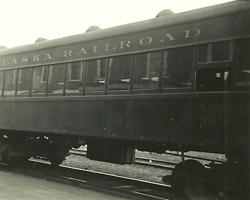 |
1. Trailer 303
often ran with Doodlebug Number 114 into Whittier from Anchorage. |
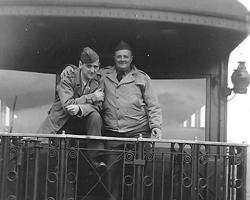 |
2. Military buddies on open
platform observation car. This is not the Seward which had an offset door
to the left side looking at the end of the car. |
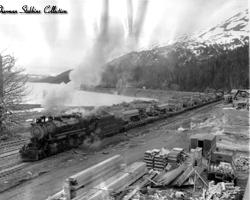 |
3. Consolidation #501 at
the head of a military supply train in Whittier cir 1943. This is very
early before any of the infrastructure was built along the water front.
The boats were bound for interior rivers to serve locations like Galena,
Tanana, Fort Yukon etc. |
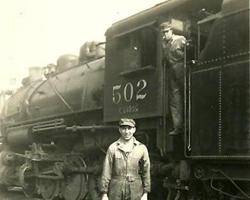 |
4. Consolidation #502 is
another old timer. The 500s were originally in the 400 class and then renumbered.
The crew is unidentified. |
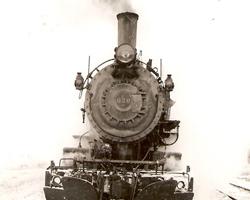 |
5. Great detail shot of Mogul
2-6-0 Number 620, one of the Panama Moguls. Notice the corners of the plow
are cut out to allow use of poling pockets. |
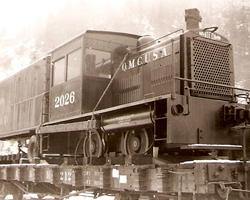 |
6. Small Whitcomb diesel
2026 from the Quarter Master Corps, United States Army aboard old Panama
flat car ARR 212?. This is a Whittier scene and I believe the locomotive
ended up at Wainwright Field at Fairbanks. |
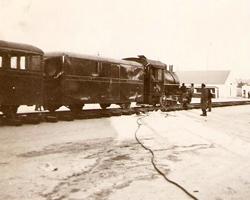 |
7. This is the Alaska Railroad
Anchorage Chamber of Commerce train in the February 1949 Fur Rendezvous
on 5th Avenue in Anchorage, Alaska. The train had been put together for
the dedication of the ARORA Passenger Service in October of 1948 at the
Anchorage Depot with the refurbished Davenport #6 aka #1 and gave rides
on Alaska Day in front of the Depot. It was such a success that they laid
temporary track down 5th Avenue for the Rondy Celebration in February and
put the little train to work. Every school kid in Anchorage got a free
ride and the regular fare was .10 for kids. - Pat Durand |
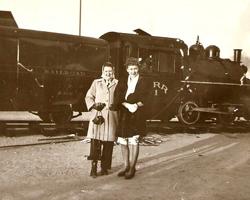 |
8. See description #7. |
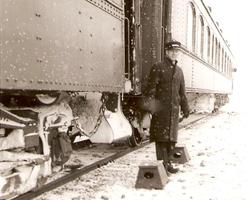 |
9. Seward |
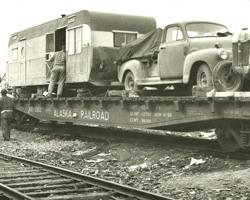 |
10. Fish-belly flat ARR 12812
most likely being loaded in Whittier. The photo is after October 1958 the
build date of the flat car. I suggest it is during the Whittier cleanup
after the military left and turned the property over to the Alaska Railroad.
There were over one hundred old travel trailers and house trailers abandoned
in Whittier. They were brought in in the early 50's to house civilian and
military families during construction of the Hodge Building and other facilities. |
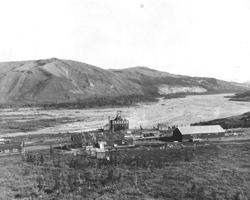 |
11. Back of picture says,"Train
Depot on Nenana River, Healy, Alaska September 19,1923". Nice row
of old drop end gondolas. To the bottom right there's a neat car that
looks like maybe a portable stem driven saw mill. There's a man and a
woman in
the picture by the outhouses behind the center building. - Sherman
Stebbins
This very early view of the Healy Section House and coaling facility begs
comparison to present day views. This was the last level piece of ground
for development of a yard before the tracks entered Nenana Canyon upriver
to the right. The wild braided nature of the river juncture here is evident.
What cannot be seen is any track going up the river bottom and a river
crossing to get to the Suntrana Coal seams open to view up the river on
the left. - Pat Durand |
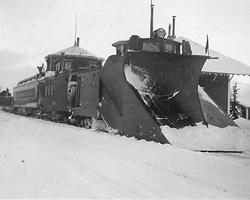 |
12. This is an unusual arrangement
for a Russel Snow plow being pushed by a string of equipment. Much more
likely it is being towed at the rear of the mixed train to a new location
RR South of Willow. Note there is no coupler on the front of the Russel
Plow. 1940s |
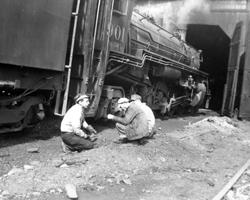 |
13. Alaska Railroad Pacific
4-6-0 #901 in the summer of 1943 at the Seward engine house. Note the Vestibule
Cab and the the poling pole and tow cable on the side of the tender frame.
The hostlers job here was to keep the locomotives warm and ready for any
call to duty. |
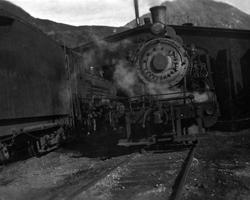 |
14. No number can be read
on the smoke box plate of this Panama Mogul from the 200 class. She is
being kept in steam here in the cinder littered ready track at the Seward
Engine house. Seward Roundhouse Summer '43
The locomotive on the left appears to be ARR 901. |
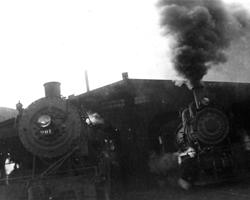 |
15. Pacific ARR 901 has been
turned on the wye and stands ready at the Seward engine house along side
the unnumbered Mogul. There was no turn table at Seward. In fact the only
turntable on the Alaska Railroad was located in Anchorage. Turning trains
and locomotives at other locations was done on a wye which was much less
challenging to maintain in the winter. 1943 |
 |
16. The Seward Engine House
in 1943 shows a rough and tumble operation. The tank car on the right may
be in for some wheel work. Looks like an old axle set at the right. The
photographer was being photographed as well. |
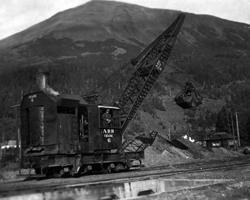 |
17. Locomotive Steam Crane
Number 6 was equipped with a clam shell bucket and provided multiple services
at Seward. Including cleaning out the ash pit that can be seen in the photo
foreground. This machine was probably kept in steam most of the time as
it would also be needed to fill the coal bunkers on all the steam engines
as there was no coaling tower in Seward. |
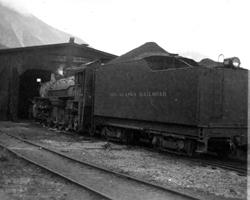 |
18. The heaviest locomotive
in service on the Seward division in steam days, was Mountain 4-8-2 ARR
Number 802 seen here simmering in front of the Seward Engine house. As
of this photo date she no longer was equipped with a trailing truck booster.
1943 |
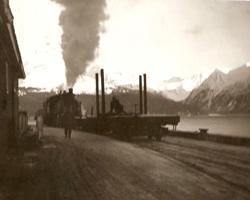 |
19. The loco is one of the
200 class Panama Moguls but I have no idea what number. I can tell you
this is not Whittier but rather Seward. The view is looking due East across
Resurrection Bay from about where the Sea Life Center is located in Seward
today. Time frame could be any where from 1919 through the 1946 when the
last 200 class locomotive was retired. An example would be #224 with a
slope back tender that was retired in 1946. - Pat Durand |
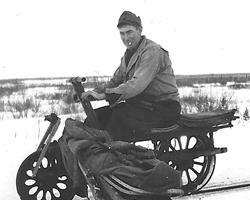 |
20.The three wheeled Velocipede
was powered by the handle bars and pedals on the crank rod connected to
the crank pin on the rear wheel. Sort of a rowing machine adapted to power
the hand car. With the extra seat behind the rider there is probably another
set of foot pegs on the crank rod. In some cases there was a seat on each
end so two people could ride and pedal and work the hand bar. With two
sets of handles you could call this a two speed velocipede with High and
Low gear. We have a double ender of very similar design at the Museum of
Alaska Transportation and Industry. They were normally painted yellow or
red for visibility. |
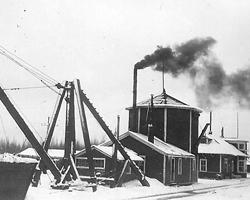 |
21. The Willow Station and
Depot cir 1940-45 is typical of the many water stops and fueling operations
along the Alaska Railroad at that time. There were coal bunkers with chutes
in Anchorage, Healy, and Fairbanks. All other locations depended on the
stiff leg cranes and track side open bunkers to do the job. The boiler
house seen here provided central steam heat and electrical power. This
was augmented with coal stoves. Back up electrical power was commonly supplied
by a single cylinder Witte generator set and batteries. |
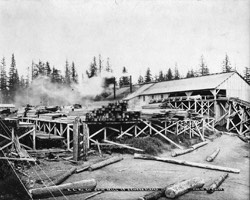 |
22. I imagine this mill would have been the first structure built in Seward when the A.C.R.R. (Alaska Central Railroad) started 1903-1904? No date on the photo but I imagine a mill this massive must have been built at the earliest start of construction. On the left side of the photo you can see a flat car on tracks ready to be loaded from the dock. |





















